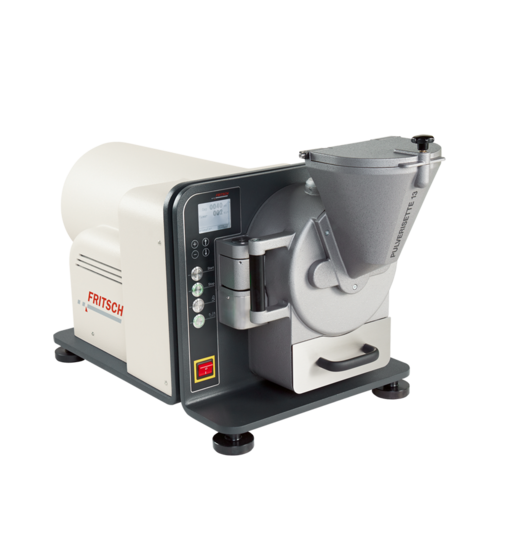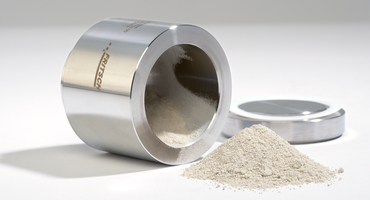Divers Broyeurs à billes
AUTRES GROUPES DE PRODUITS
Micro-broyeur à vibrations
PULVERISETTE 0
Veuillez tenir compte des points suivants : Le broyeur à billes à vibrations FRITSCH PULVERISETTE 0 doit être complété d'un mortier équipé d'une bille de broyage. Le matériau du mortier doit toujours être plus dur que le matériau à broyer. En règle générale, le mortier et les billes de broyage utilisés sont fabriqués dans le même matériau. Tous les mortiers FRITSCH – quel que soit le matériau – sont sertis dans un socle en aluminium résistant aux chocs, qui protège le mortier.
La Kryo-Box FRITSCH est destinée à fragiliser des matériaux mous, légèrement gras ou humides afin des soumettre à un broyage cryogénique.
Pour que le broyage et le tamisage soient regroupés en un seul instrument, combinez le broyeur PULVERISETTE 0 avec la
tamiseuse à vibrations ANALYSETTE 3 SPARTAN
MORTIERS
-
Caractéristiques matériau mortier/billes de broyage
Matériau Composant principal du matériau Densité en g/cm³ Résistance à l'abrasion Type d'échantillon agate SiO2 2,65 bonne échantillons mous à mi-durs corindon fritté Al2O3(99,7 %) 3,8 relativement bonne échantillons fibreux, mi-durs oxyde de zirconium ZrO2 5,7 très bonne échantillons fibreux, abrasifs acier trempé, inoxydable Fe - Cr 7,7 bonne échantillons durs, mi-durs, cassants métal dur carbure de tungstène WC 14,3 très bonne échantillons très durs, abrasifs -
Autres informations
En règle générale, le bol de broyage et les billes utilisés sont fabriqués dans le même matériau.
Dans le cas d'un broyage cryogénique, il est recommandé d'utiliser des mortiers et des billes de broyage en acier ou en carbure de tungstène. Les garnitures de broyage en agate ou en corindon fritté sont incompatibles avec le broyage cryogénique.

Choisissez 1 mortier en l'un des 6 matériaux disponibles, permettant d'adapter parfaitement le broyage à chaque type d'échantillon. Veuillez utiliser des mortiers et des billes de broyage en acier ou en carbure de tungstène pour le broyage cryogénique. Des informations détaillées concernant les caractéristiques des matériaux se trouvent dans l'aide à la sélection, qui vous aident à adapter au mieux le matériau de l'échantillon au mortier et aux billes de broyage.
MORTIERS

General material specification:
Material: agate - SiO2
Abrasion resistance: good
Suitable for: soft to medium-hard samples
Detailed information about the material you will find in the element analysis.
| General specifications | |
| Material | Agate – SiO2 |
| Chemical composition | |
| Element | Share % |
| Silicon oxide– SiO2 | 99.9 |
| Aluminium – Al2O3 | < 0.02 |
| Iron oxide – Fe2O3 | < 0.02 |
| Calcium oxide – CaO | < 0.02 |
| Magnesium oxide – MgO | < 0.02 |
| Sodium oxide – Na2O | < 0.02 |
| Potassium oxide – K2O | < 0.02 |
| Manganese oxide – MnO | < 0.02 |
| Physical and mechanical properties | |
| Density | 2.65 g/cm³ |
| Hardness | 6.5 – 7 Mohs |
Explanations on hardness data

General material specification:
Material: sintered corundum 1 - Al2O3
Abrasion resistance: fairly good
Suitable for: medium-hard, fibrous samples
Detailed information about the material you will find in the element analysis.
| General specifications | |
| Material | Sintered corundum 1 – Al2O3 |
| ISO/EN/DIN code | |
| Chemical composition | |
| Element | Share % |
| Aluminium oxide – Al2O3 | 99.651 |
| Silicon oxide – SiO2 | 0.257 |
| Calcium oxide – CaO | 0.081 |
| Other | 0.011 |
| Physical and mechanical properties | |
| Density | 3.8 g/cm³ |
| Hardness | 18.000N/mm² (Vickers HV 0.5) |
Explanations on hardness data

General material specification:
Material: zirconium oxide ZrO2
Abrasion resistance: very good
Suitable for: fibrous, abrasive samples
Detailed information about the material you will find in the element analysis.
| General specifications | |
| Material | Zirconium oxide - ZrO2 |
| Chemical composition | |
| Element | Share % |
| Zirconium oxide – ZrO2 | 94.2 - 95.2 |
| Hafnium oxide – HfO2 | 1 - 2 |
| Magnesium oxide – MgO | 3.5 |
| Silicon dioxide – SiO | 0.1 |
| Aluminium oxide – Al2O3 | 0.1 |
| Other | 0.1 |
| Physical and mechanical properties | |
| Density | 5.7 g/cm³ |
| Hardness Vickers | 1200 (HV10) |
Explanations on hardness data

General material specification:
Material: hardened, stainless steel - Fe-Cr
Abrasion resistance: good
Suitable for: medium-hard, brittle samples, suitable for cryogenic grinding
Detailed information about the material you will find in the element analysis.
| General specifications | |
| Material | hardened stainless steel – 1.4125 |
| ISO/EN/DIN code | X105CrMo17 |
| Chemical composition | |
| Element | Share % |
| Iron– Fe | 81.4 |
| Chromium – Cr | 17 |
| Carbon – C | 1.1 |
| Molybdenum – Mo | 0.5 |
| Physical and mechanical properties | |
| Density | 7.7 kg/dm³ |
| Hardness | ~ 60 HRC |
Explanations on hardness data

General material specification:
Material: hardmetal tungsten carbide - WC
Abrasion resistance: very good
Suitable for: hard, abrasive samples, very suitable for cryogenic grinding
Detailed information about the material you will find in the element analysis.
| General specifications | |
| Material | Tungsten carbide - WC |
| ISO/EN/DIN code | |
| Chemical composition | |
| Element | Share % |
| Tungsten carbide – TC | 88 |
| Cobalt – Co | 12 |
| Physical and mechanical properties | |
| Density | 14.3 g/cm³ |
| Hardness | 89.7 HRA |
Explanations on hardness data
BILLES DE BROYAGE
-
Caractéristiques matériau mortier/billes de broyage
Matériau Composant principal du matériau Densité en g/cm³ Résistance à l'abrasion Type d'échantillon agate SiO2 2,65 bonne échantillons mous à mi-durs corindon fritté Al2O3(99,7 %) 3,8 relativement bonne échantillons fibreux, mi-durs oxyde de zirconium ZrO2 5,7 très bonne échantillons fibreux, abrasifs acier trempé, inoxydable Fe - Cr 7,7 bonne échantillons durs, mi-durs, cassants métal dur carbure de tungstène WC 14,3 très bonne échantillons très durs, abrasifs -
Autres informations
En règle générale, le bol de broyage et les billes utilisés sont fabriqués dans le même matériau.
Dans le cas d'un broyage cryogénique, il est recommandé d'utiliser des mortiers et des billes de broyage en acier ou en carbure de tungstène. Les garnitures de broyage en agate ou en corindon fritté sont incompatibles avec le broyage cryogénique.

Nous proposons des billes de broyage de différents diamètres compris entre 50 et 70 mm et en 6 matériaux différents, pour garantir le meilleur résultat de broyage possible. Veuillez utiliser des mortiers et des billes de broyage en acier ou en carbure de tungstène pour le broyage cryogénique. Des informations détaillées concernant les caractéristiques des matériaux se trouvent dans l'aide à la sélection, qui vous aident à adapter au mieux le matériau de l'échantillon au mortier et aux billes de broyage.
BILLES DE BROYAGE

General material specification:
Material: agate - SiO2
Abrasion resistance: good
Suitable for: soft to medium-hard samples
Detailed information about the material you will find in the element analysis.
We also offer a grinding ball made of agate with 70 mm dia. This 70 mm grinding ball causes a higher application of energy, but is only suitable for grinding fine materials and therefore only be recommendable for special applications.
| General specifications | |
| Material | Agate – SiO2 |
| Chemical composition | |
| Element | Share % |
| Silicon oxide– SiO2 | 99.9 |
| Aluminium – Al2O3 | < 0.02 |
| Iron oxide – Fe2O3 | < 0.02 |
| Calcium oxide – CaO | < 0.02 |
| Magnesium oxide – MgO | < 0.02 |
| Sodium oxide – Na2O | < 0.02 |
| Potassium oxide – K2O | < 0.02 |
| Manganese oxide – MnO | < 0.02 |
| Physical and mechanical properties | |
| Density | 2.65 g/cm³ |
| Hardness | 6.5 – 7 Mohs |
Explanations on hardness data

General material specification:
Material: agate - SiO2
Abrasion resistance: good
Suitable for: soft to medium-hard samples
Detailed information about the material you will find in the element analysis.
The grinding ball made of agate with 50 mm dia. is recommended as standard.
| General specifications | |
| Material | Agate – SiO2 |
| Chemical composition | |
| Element | Share % |
| Silicon oxide– SiO2 | 99.9 |
| Aluminium – Al2O3 | < 0.02 |
| Iron oxide – Fe2O3 | < 0.02 |
| Calcium oxide – CaO | < 0.02 |
| Magnesium oxide – MgO | < 0.02 |
| Sodium oxide – Na2O | < 0.02 |
| Potassium oxide – K2O | < 0.02 |
| Manganese oxide – MnO | < 0.02 |
| Physical and mechanical properties | |
| Density | 2.65 g/cm³ |
| Hardness | 6.5 – 7 Mohs |
Explanations on hardness data

General material specification:
Material: sintered corundum 1 - 99.7 % Al2O3
Abrasion resistance: fairly good
Suitable for: medium-hard, fibrous samples
Detailed information about the material you will find in the element analysis.
| General specifications | |
| Material | Sintered corundum 1 – Al2O3 |
| ISO/EN/DIN code | |
| Chemical composition | |
| Element | Share % |
| Aluminium oxide – Al2O3 | 99.651 |
| Silicon oxide – SiO2 | 0.257 |
| Calcium oxide – CaO | 0.081 |
| Other | 0.011 |
| Physical and mechanical properties | |
| Density | 3.8 g/cm³ |
| Hardness | 18.000N/mm² (Vickers HV 0.5) |
Explanations on hardness data

General material specification:
Material: zirconium oxide ZrO2
Abrasion resistance: very good
Suitable for: fibrous, abrasive samples
Detailed information about the material you will find in the element analysis.
| General specifications | |
| Material | Zirconium oxide - ZrO2 |
| Chemical composition | |
| Element | Share % |
| Zirconium oxide – ZrO2 | 94.2 - 95.2 |
| Hafnium oxide – HfO2 | 1 - 2 |
| Magnesium oxide – MgO | 3.5 |
| Silicon dioxide – SiO | 0.1 |
| Aluminium oxide – Al2O3 | 0.1 |
| Other | 0.1 |
| Physical and mechanical properties | |
| Density | 5.7 g/cm³ |
| Hardness Vickers | 1200 (HV10) |
Explanations on hardness data

General material specification:
Material: hardened, stainless steel - Fe-Cr
Abrasion resistance: good
Suitable for: medium-hard, brittle samples
Detailed information about the material you will find in the element analysis.
| General specifications | |
| Material | hardened stainless steel – 1.4125 |
| ISO/EN/DIN code | X105CrMo17 |
| Chemical composition | |
| Element | Share % |
| Iron– Fe | 81.4 |
| Chromium – Cr | 17 |
| Carbon – C | 1.1 |
| Molybdenum – Mo | 0.5 |
| Physical and mechanical properties | |
| Density | 7.7 kg/dm³ |
| Hardness | ~ 60 HRC |
Explanations on hardness data

General material specification:
Material: hardmetal tungsten carbide - WC
Abrasion resistance: very good
Suitable for: hard, abrasive samples
Detailed information about the material you will find in the element analysis.
| General specifications | |
| Material | Tungsten carbide - WC |
| ISO/EN/DIN code | |
| Chemical composition | |
| Element | Share % |
| Tungsten carbide – TC | 88 |
| Cobalt – Co | 12 |
| Physical and mechanical properties | |
| Density | 14.3 g/cm³ |
| Hardness | 89.7 HRA |
Explanations on hardness data
ACCESSOIRES SPÉCIAUX

La Kryo-Box FRITSCH est destinée à fragiliser des matériaux mous, légèrement gras ou humides afin des soumettre à un broyage cryogénique. Il suffit de mettre en place la garniture de broyage remplie puis d'ajouter de l'azote liquide – mêmes les échantillons les plus difficiles à broyer se fragmentent facilement à la finesse requise pour l'analyse. La bonne isolation assure une consommation de réfrigérant particulièrement faible.
Des couvercles de tamisage spécifiques sont également disponibles pour un tamisage à sec et par voir humide.
Nous recommandons d'utiliser une cloche d'insonorisation pour réduire les bruits émis par le broyage.
ACCESSOIRES POUR BROYAGE CRYOGÉNIQUE

Device for grinding in liquid nitrogen.
The grinding set is placed in a cryo-box to grind soft, oily, fatty or moist materials by adding liquid nitrogen to embrittle the grinding material. This method is used to reduce samples which are very difficult to grind (e. g. slivers of soft PVC) to analytical fineness. The thick insulation of the cryo-box keeps coolant costs low.
For cryogenic grinding, a mortar and a grinding ball made of stainless steel, tempered steel or hard metal tungsten carbide should be used.
Please note: Grinding sets made of agate and sintered corundum cannot be used in the cryo-box.
Cloche d'insonorisation
To reduce the grinding sound, we recommend the sound absorption hood made of plexiglas.
COUVERCLE DE TAMISAGE

For dry sieving with test sieves 200 mm/8" dia.
The clamping lid made of plexiglas allows the operator to observe the sieving process.
For applications, where it is not required to observe the sieving process, a clamping lid without window insert article no. 31.2050.00, is also available.
This clamping lid can also be used if you would like to use the Vibratory Micro Mill PULVERISETTE 0 as a Vibratory Sieve Shaker ANALYSETTE 3 SPARTAN. The needed sieve pan and the sieves must be ordered separately.

For dry sieving for all test sieves up to 200 mm/8" dia.
The POM plastic clamping lid without window for applications, where it is not required to observe the sieving process, respectively in order to sieve materials where a metallic contamination must be avoided. For applications, where it is required to observe the sieving process, a clamping lid with window insert article no. 31.2020.00, is also available.
This clamping lid can also be used if you would like to use the Vibratory Micro Mill PULVERISETTE 0 as a Vibratory Sieve Shaker ANALYSETTE 3 SPARTAN.
The needed sieve pan and the sieves must be ordered separately.
| General specifications | |
| Material | POM Polyoxymethylene |
| ISO/EN/DIN Code | DIN 7728 C9021 |
| Chemical composition | |
| Element | Formula |
| Polyoxmethylenecopolymer (Polyacetale) | CxH2xOx |
| Melting point | 165° C |
| max. Application temp. constant | 90° |
| max. Application temp. briefly | 140° |
| Chemical Resistance | |
| Aliphatical hydrocarbon | |
| Aromatical hydrocarbon | |
| Halogenised hydrocarbon | |
| weak acid | |
| strong alkaline solution | |
| Physical and mechanical properties | |
| Density | 141,g /cm³ |
| Hardness | extremely hard |

With 2 rotation nozzles for wet sieving with test sieves 200 mm/8" dia.
The wet clamping lid features 2 rotation nozzles which sprays the entire interior chamber, thus helping to flush the material through the sieve apertures.
Especially recommended for materials with a high electrostatic charge or very high content of fine material. This clamping lid can also be used if you would like to use the Vibratory Micro Mill PULVERISETTE 0 as a Vibratory Sieve Shaker ANALYSETTE 3 SPARTAN. The needed sieve pan and the sieves must be ordered separately.
CERTIFICATION

IQ/OQ documentation (questionnaire format - implementation by customer) for the independent support of instrument qualification in the quality management system for the Vibratory Micro Mill PULVERISETTE 0.











